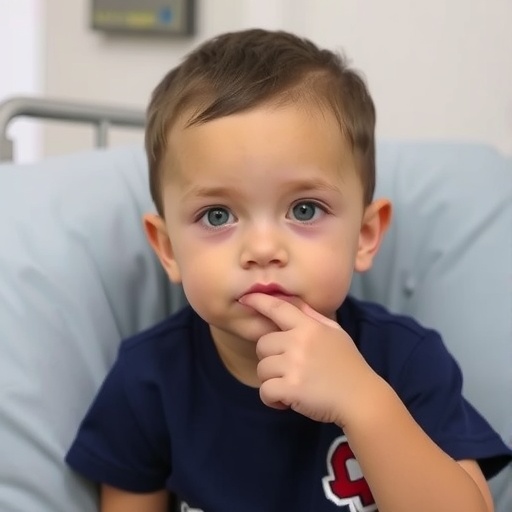In the evolving landscape of pediatric autoimmune disorders, Behçet’s disease stands out for its enigmatic presentations and complex pathophysiology. The recent study by Zou and Guan, published in World Journal of Pediatrics in 2025, offers an unprecedented in-depth analysis of pediatric Behçet’s disease clusters, shedding light on the intricacies of this rare but devastating condition. This comprehensive investigation not only challenges existing paradigms but also paves the way for novel therapeutic approaches and refined diagnostic criteria.
Behçet’s disease, characterized by recurrent oral and genital ulcers, skin lesions, and ocular inflammation, manifests uniquely in children compared to adult populations. The pediatric form frequently presents diagnostic dilemmas due to its heterogeneous clinical spectrum and overlap with other inflammatory disorders. Zou and Guan’s research meticulously dissects these complexities, employing advanced epidemiological clustering techniques to identify distinct pediatric subtypes, which bear profound implications for prognosis and management.
Central to this study is the concept of “disease clusters,” which refers to the grouping of patients based on shared clinical features, genetic predispositions, and biomolecular signatures. Leveraging a vast multicenter cohort, the authors exploited machine learning algorithms to cross-examine vast datasets encompassing immunologic profiles, HLA genotypes, cytokine expressions, and environmental triggers. This multifactorial analysis revealed previously unrecognized clusters, each marked by unique immunopathological pathways driving disease activity in children.
.adsslot_eNtkg0QjGw{ width:728px !important; height:90px !important; }
@media (max-width:1199px) { .adsslot_eNtkg0QjGw{ width:468px !important; height:60px !important; } }
@media (max-width:767px) { .adsslot_eNtkg0QjGw{ width:320px !important; height:50px !important; } }
ADVERTISEMENT
The classification of pediatric Behçet’s clusters advances understanding beyond the classical narrative of monolithic disease models. Zou and Guan identified at least four major clusters, distinguished according to patterns of systemic involvement and serological markers. One cluster emphasized predominant mucosal ulcerations coupled with heightened neutrophil activation, while another was distinguished by early-onset vascular inflammation and a proclivity toward thrombotic complications. This nuanced stratification underscores the necessity for cluster-specific diagnostic and therapeutic regimens.
From a mechanistic standpoint, the study delves deep into the aberrations of immune regulation observed in these pediatric cohorts. Elevated pro-inflammatory cytokines, including interleukin-6, tumor necrosis factor-alpha, and interleukin-17, were conspicuously prominent across all clusters but displayed distinctive expression profiles. The interconnection between innate immune dysregulation and adaptive immune responses further elucidates the persistent inflammation characteristic of Behçet’s pathology in children. Zou and Guan’s revelations point toward a critical role of innate immunity’s crosstalk with T-helper 17 cells, offering a fertile ground for targeted immunomodulatory interventions.
Genetic predisposition, particularly the association with HLA-B51, continues to be a significant determinant in Behçet’s disease susceptibility and expression. The study’s sophisticated genotypic analysis highlighted varying allelic frequencies of HLA-B51 within the defined clusters, suggesting that genetic backgrounds influence not only disease susceptibility but also phenotypic expression and severity. Importantly, the interplay between genetics and environmental factors such as microbial exposure and geographic variability further refines the understanding of disease clustering within pediatric populations.
Environmental triggers have long been hypothesized as catalysts for disease onset and flares in Behçet’s, yet their precise role remained elusive. Zou and Guan’s research incorporated geo-epidemiological mapping and longitudinal exposure assessments, linking certain microbial antigens and climatic conditions to distinct cluster emergence. This unprecedented integration of environmental data demonstrates how exogenous factors converge with intrinsic immunogenetics to modulate disease trajectories in children.
Clinically, this stratified cluster approach revolutionizes traditional management strategies. The identification of cluster-specific biomarkers enables more precise monitoring of disease activity and treatment response. For example, patients within the vascular inflammation cluster may benefit from early anticoagulant therapy coupled with anti-cytokine biologics, whereas those in the mucosal-ulcerative cluster might respond better to immunosuppressants targeting neutrophil activation pathways. Such tailored interventions promise to reduce the morbidity traditionally associated with empirical treatment regimens.
Moreover, the psychological and developmental impacts of pediatric Behçet’s disease are profound yet often underappreciated. The authors emphasize the importance of integrating psychosocial assessments and quality-of-life metrics into clinical protocols. Their data reveal that different clusters also carry divergent psychosocial burdens, necessitating multidisciplinary care involving rheumatologists, immunologists, mental health professionals, and pediatric care providers to holistically support affected children and their families.
Another innovative aspect of Zou and Guan’s study is the adoption of cutting-edge omics technologies, including transcriptomics and proteomics, enabling an unparalleled resolution in characterizing molecular signatures within each cluster. This systems biology approach not only validates clinical phenotyping but also uncovers novel therapeutic targets, including non-coding RNAs and epigenetic regulators, which modulate immune responses in pediatric Behçet’s disease.
The cross-disciplinary collaboration underlying this research exemplifies the future of pediatric autoimmune disease investigation. By converging expertise in immunology, genetics, bioinformatics, and clinical pediatrics, this study constructs a comprehensive framework for understanding and managing Behçet’s disease in children. The methodological rigor and innovative analytical approaches employed set a new benchmark for subsequent research in this domain.
Future directions, as proposed by Zou and Guan, focus on expanding longitudinal cohort studies to validate these clusters and test tailored interventions in clinical trials. They advocate for international consortia to standardize data collection and share findings to accelerate discovery and improve patient outcomes globally. Integrating artificial intelligence and real-world clinical data further promises to refine disease classification and personalize therapeutic decision-making.
In conclusion, Zou and Guan’s seminal work represents a paradigm shift in the comprehension of pediatric Behçet’s disease, unraveling its multifaceted nature through robust clustering analysis. Their insights forge pathways toward precision medicine approaches, wherein children afflicted by this complex disorder receive individualized care based on their specific immunogenetic and environmental profiles. This landmark study heralds a new era in pediatric rheumatology, bringing hope for improved prognosis and quality of life for countless children worldwide.
As Behçet’s disease continues to challenge clinicians and researchers alike, this comprehensive exploration of pediatric clusters underscores the critical need for multidisciplinary, data-driven strategies. It highlights the potential for biomarker-guided therapies and emphasizes the profound benefits such advances hold for early diagnosis, effective treatment, and holistic patient management.
With its robust scientific foundation and visionary outlook, this research not only enriches the academic community but also resonates with affected patients and families, illuminating the path toward conquest of pediatric Behçet’s disease in the years to come.
Subject of Research: Pediatric Behçet’s disease clusters and their immunogenetic and environmental complexities
Article Title: Unraveling the complexities of pediatric Behçet’s disease clusters
Article References: Zou, J., Guan, JL. Unraveling the complexities of pediatric Behçet’s disease clusters. World J Pediatr (2025). https://doi.org/10.1007/s12519-025-00933-3
Image Credits: AI Generated
DOI: https://doi.org/10.1007/s12519-025-00933-3
Tags: autoimmune disorders in childrenclinical features of Behçet’s diseasecytokine expressions in autoimmune disordersdiagnostic criteria for pediatric Behçet’senvironmental triggers of Behçet’sepidemiological clustering techniques in medicineHLA genotypes and Behçet’s diseaseimmunologic profiles in Behçet’smachine learning in pediatric researchnovel therapeutic approaches for Behçet’spediatric autoimmune disease managementpediatric Behçet’s disease complexities





